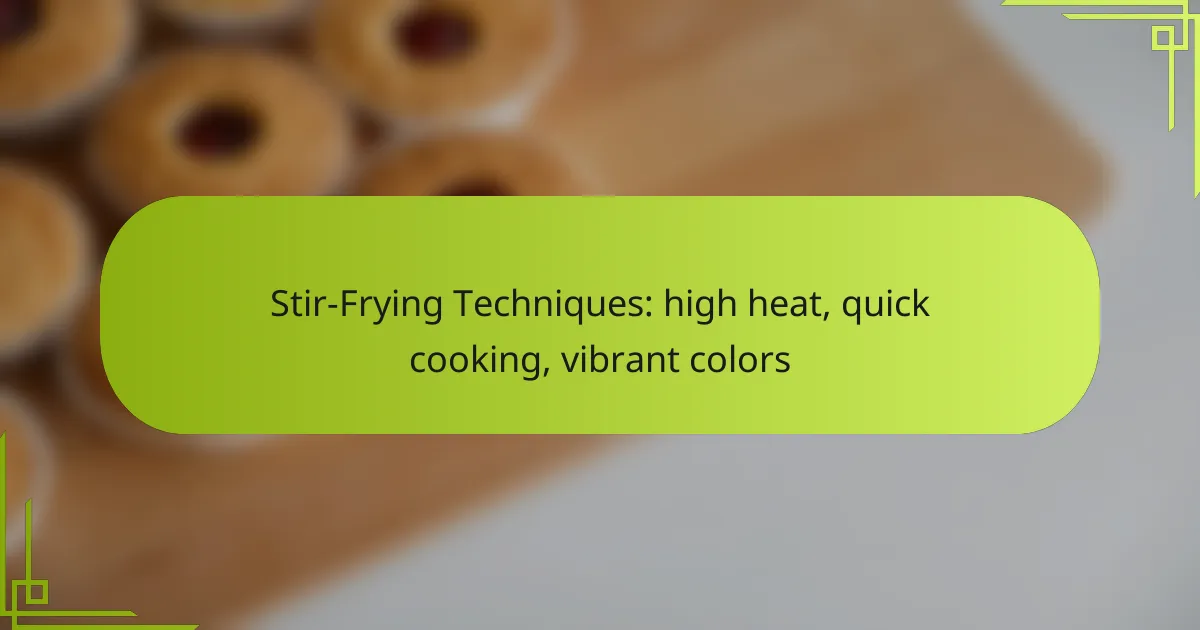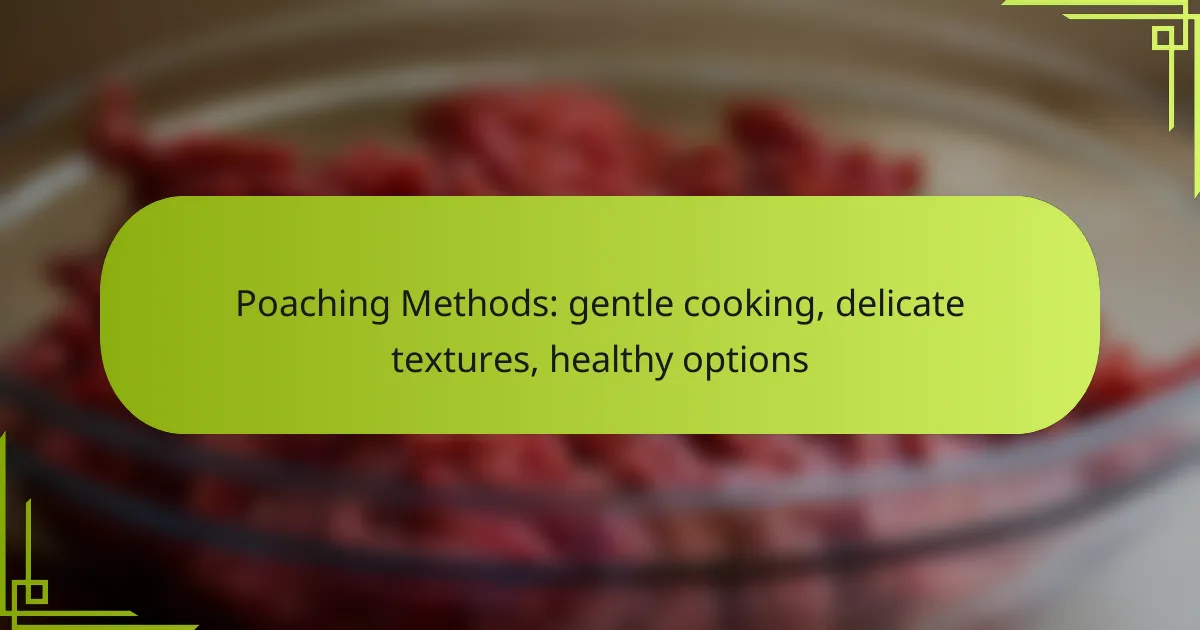Pickling is a time-honored preservation technique that not only extends the shelf life of vegetables but also infuses them with tangy, complex flavors. Methods such as water bath canning and fermentation are popular for long-term storage, while quick pickling offers a fast way to enjoy fresh, zesty tastes. The versatility of pickled foods allows them to enhance a wide range of dishes, from salads to cocktails, making them an essential ingredient in creative culinary applications.
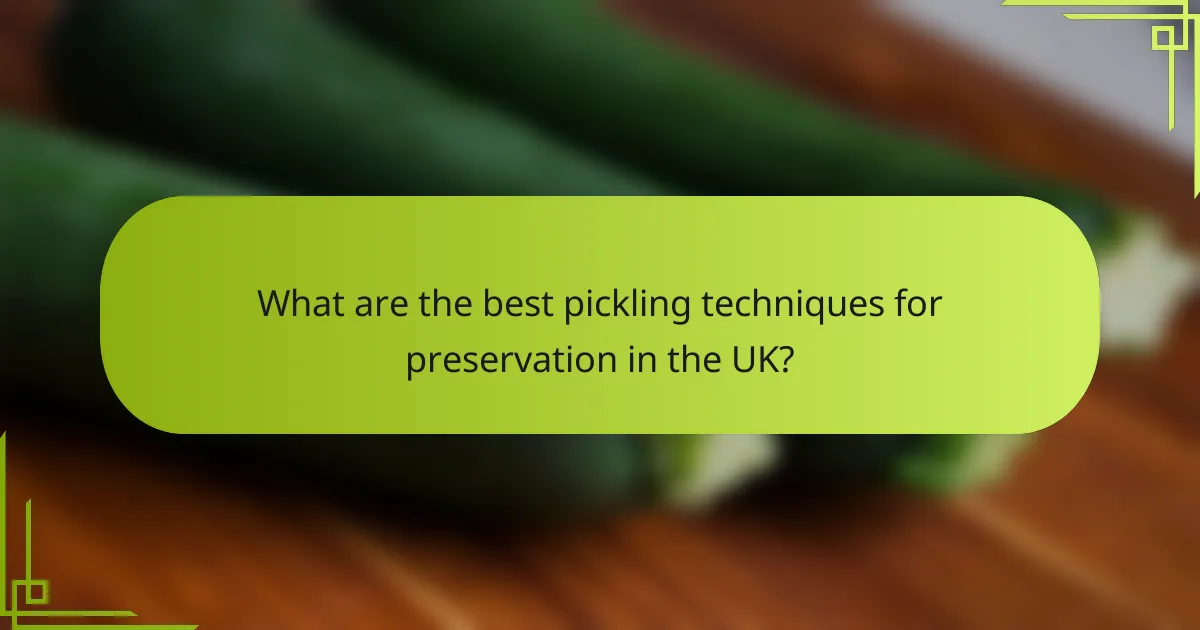
What are the best pickling techniques for preservation in the UK?
The best pickling techniques for preservation in the UK include methods that enhance shelf life while maintaining flavor. Popular techniques such as water bath canning and fermentation are effective for long-term storage, while quick pickling offers a speedy alternative for immediate use.
Water bath canning
Water bath canning is a popular method for preserving high-acid foods like fruits and pickled vegetables. This technique involves submerging jars in boiling water for a specified time to create a vacuum seal, preventing spoilage. Ensure jars are properly sterilized and follow guidelines for processing times based on jar size and food type.
For best results, use a canning pot with a rack to avoid direct contact with the bottom. Always check the seals after cooling; any unsealed jars should be refrigerated and consumed promptly.
Fermentation
Fermentation is a natural preservation method that relies on beneficial bacteria to create an acidic environment, which helps preserve food. This technique not only extends shelf life but also enhances flavors and adds probiotic benefits. Common fermented pickles include sauerkraut and kimchi.
To ferment, submerge vegetables in a saltwater brine and allow them to sit at room temperature for several days to weeks, depending on the desired tanginess. Monitor for bubbles and taste periodically to achieve the right flavor profile.
Refrigerator pickling
Refrigerator pickling is a quick and easy method that requires no canning equipment. This technique involves immersing vegetables in a vinegar-based brine and storing them in the fridge. The pickles can be ready to eat in just a few hours, making it ideal for last-minute preparations.
Use a ratio of one part vinegar to one part water, adding sugar and spices to taste. Store in airtight containers and consume within a few weeks for optimal freshness.
Pressure canning
Pressure canning is essential for preserving low-acid foods, such as meats and vegetables, as it reaches higher temperatures than water bath canning. This method effectively kills harmful bacteria and ensures long-term storage. It requires a pressure canner, which is designed to maintain the necessary pressure for safe processing.
Follow specific guidelines for processing times based on the type of food and jar size. Always check the pressure gauge and ensure that the canner is properly sealed to avoid accidents during the canning process.
Quick pickling
Quick pickling is a fast method that allows for immediate enjoyment of pickled foods. This technique typically involves heating a vinegar brine and pouring it over vegetables, which are then left to cool before refrigerating. Quick pickles can be ready in a matter of hours, making them perfect for spontaneous meals.
Experiment with various spices and flavorings in the brine, such as garlic, dill, or chili flakes, to customize the taste. Store quick pickles in the fridge and consume within a few weeks for the best flavor and texture.
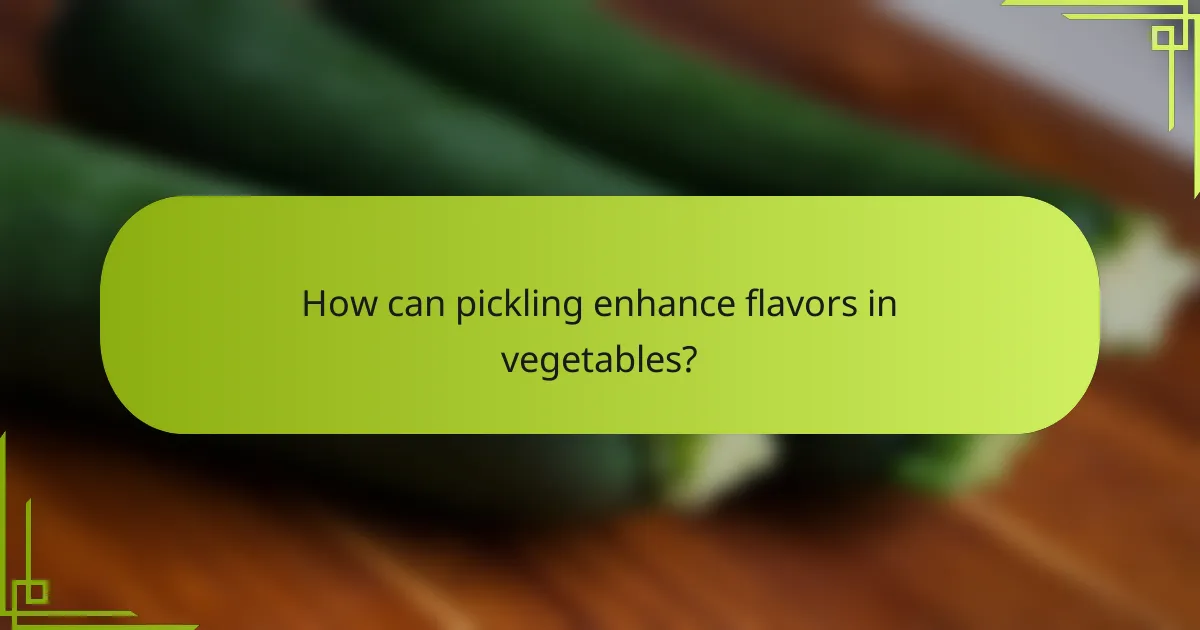
How can pickling enhance flavors in vegetables?
Pickling enhances flavors in vegetables by introducing tangy, acidic notes that complement their natural taste. This preservation method not only extends shelf life but also adds complexity through various ingredients and techniques.
Use of vinegar types
The type of vinegar used in pickling significantly affects the flavor profile of the vegetables. Common options include white vinegar, apple cider vinegar, and rice vinegar, each imparting distinct tastes. For instance, apple cider vinegar adds a fruity note, while rice vinegar offers a milder, sweeter flavor.
When selecting vinegar, consider the acidity level, typically around 5% for most pickling purposes. Experimenting with different vinegars can lead to unique and personalized pickling results.
Spice blends for flavor
Incorporating various spices into the pickling brine can elevate the flavor of the vegetables. Common spices include mustard seeds, coriander, dill, and peppercorns, which can be adjusted based on personal preference. A typical blend might include a teaspoon of mustard seeds and a few peppercorns per quart of brine.
To avoid overwhelming the vegetables, start with smaller amounts of spices and adjust in subsequent batches. This allows for a tailored flavor experience while ensuring the spices complement rather than overpower the main ingredients.
Herb infusions
Herbs can be infused into the pickling process to add freshness and aromatic qualities. Popular choices include dill, thyme, and basil, which can be added directly to the brine or layered with the vegetables. For example, a few sprigs of dill can enhance cucumber pickles significantly.
When using herbs, consider their potency; fresh herbs may require more than dried ones. A good rule of thumb is to use about one tablespoon of fresh herbs or one teaspoon of dried herbs per quart of brine, adjusting as needed for desired intensity.
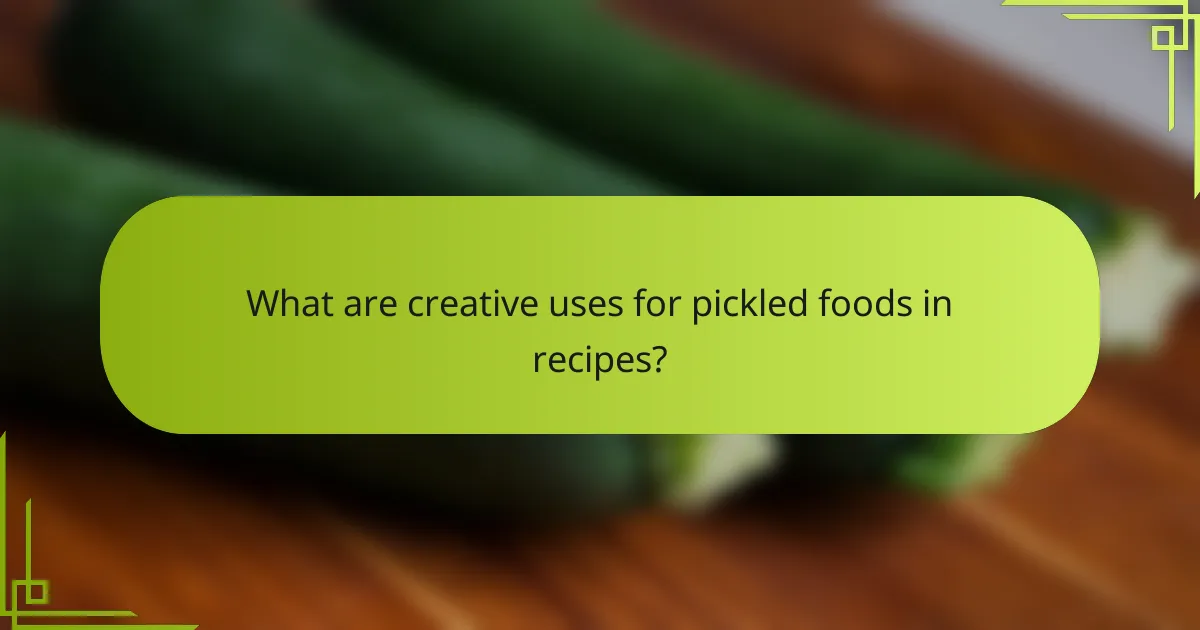
What are creative uses for pickled foods in recipes?
Pickled foods can enhance a variety of dishes by adding tangy flavors and unique textures. Their versatility allows them to be incorporated into salads, cocktails, sandwiches, and sauces, making them a valuable ingredient in many culinary creations.
Pickled salads
Pickled salads offer a refreshing twist on traditional greens, combining the crunch of fresh vegetables with the zesty kick of pickles. Common ingredients include pickled cucumbers, onions, and carrots, which can be tossed with leafy greens and a light vinaigrette. Consider adding herbs like dill or parsley for extra flavor.
For a simple pickled salad, mix equal parts of pickled vegetables with fresh ingredients like tomatoes or bell peppers. This balance of flavors creates a vibrant dish that can serve as a side or a light main course.
Garnishes for cocktails
Pickled foods make excellent garnishes for cocktails, adding both visual appeal and a burst of flavor. Popular choices include pickled olives, onions, and even pickled vegetables like green beans or asparagus. These garnishes can elevate drinks like martinis or bloody marys.
When using pickled garnishes, consider the flavor profile of the cocktail. For instance, a spicy pickled pepper can complement a savory drink, while a sweet pickle might enhance a fruity cocktail. Experiment with different combinations to find the perfect match.
Sandwich toppings
Pickled foods are ideal sandwich toppings, providing a crunchy texture and tangy flavor that contrasts beautifully with meats and cheeses. Classic options include pickles, pickled jalapeños, or pickled cabbage, which can be layered onto sandwiches for added depth.
For a gourmet touch, try using pickled red onions or a mix of pickled vegetables in a banh mi or a pulled pork sandwich. These toppings can transform a simple sandwich into a flavorful meal.
Incorporating into sauces
Incorporating pickled foods into sauces can add complexity and a unique tang. For example, finely chopped pickles can enhance tartar sauce, while pickled jalapeños can spice up mayonnaise or aioli. These additions can create a delightful contrast to richer flavors.
When making sauces, start with a base and gradually mix in the pickled ingredients to achieve the desired flavor balance. Aim for a ratio of about one part pickled ingredients to three parts sauce base for a harmonious blend. Adjust to taste as you go along.

What tools are essential for home pickling?
Essential tools for home pickling include jars, canning lids, and fermentation weights. These items help ensure that your pickling process is safe, effective, and yields delicious results.
Pickling jars
Pickling jars are crucial for storing your pickled goods. Glass jars with airtight seals are preferred, as they prevent air from spoiling the contents. Common sizes range from 500 ml to 1 liter, allowing flexibility depending on the volume of produce you wish to pickle.
When selecting jars, ensure they are specifically designed for canning to withstand high temperatures during processing. Avoid using jars that previously contained non-canning products, as they may not seal properly.
Canning lids and bands
Canning lids and bands are necessary for creating a vacuum seal on your jars. The lids should be new and undamaged to ensure a proper seal, while the bands can be reused as long as they are in good condition. It’s advisable to check for rust or deformation before use.
When sealing, tighten the bands until they are fingertip-tight, but avoid over-tightening, which can prevent air from escaping during the canning process. This balance is essential for achieving a safe and effective seal.
Fermentation weights
Fermentation weights are used to keep vegetables submerged in brine during the pickling process. This is important for preventing mold and ensuring even fermentation. Weights can be made of glass or ceramic and should fit snugly inside the jar.
When using fermentation weights, ensure they are clean and food-safe. If you don’t have specific weights, you can use clean stones or other heavy objects, but make sure they are non-reactive and safe for food use.
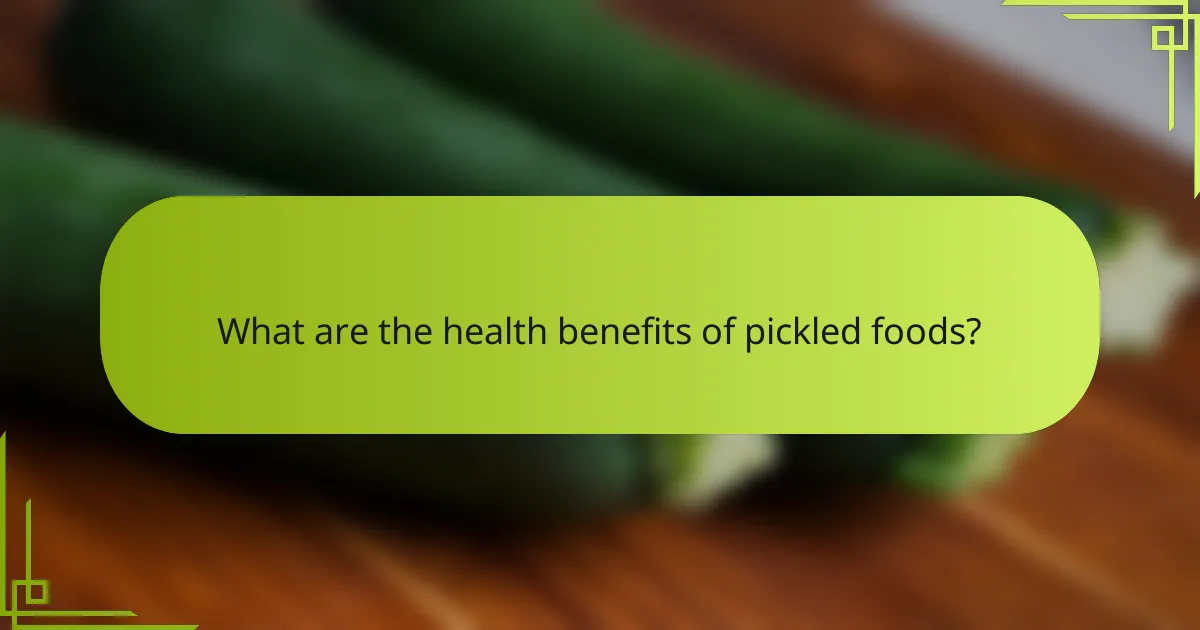
What are the health benefits of pickled foods?
Pickled foods offer various health benefits, including improved digestion, enhanced nutrient absorption, and low-calorie flavor options. These benefits stem from the fermentation process and the preservation of vitamins and minerals in the vegetables.
Probiotics from fermented pickles
Fermented pickles are rich in probiotics, which are beneficial bacteria that support gut health. These probiotics can help balance the gut microbiome, potentially improving digestion and boosting the immune system.
To maximize probiotic benefits, choose naturally fermented pickles that contain live cultures, often found in refrigerated sections of stores. Look for labels that specify “live and active cultures” to ensure you’re getting the most health benefits.
Increased nutrient absorption
Pickling can enhance the bioavailability of certain nutrients, making them easier for the body to absorb. For instance, the acidity from vinegar or fermentation can help break down food compounds, allowing for better absorption of vitamins and minerals.
Incorporating pickled foods into meals can be a simple way to increase nutrient intake. Pairing pickled vegetables with high-iron foods, like spinach or legumes, can further improve iron absorption, making it a practical addition to your diet.
Low-calorie flavor enhancers
Pickled foods are typically low in calories, making them an excellent option for adding flavor without significantly increasing caloric intake. They can be used to enhance salads, sandwiches, and various dishes, providing a tangy kick that can reduce the need for heavier dressings or sauces.
When using pickled foods as flavor enhancers, consider portion sizes to maintain a balanced diet. A few slices of pickled cucumbers or a spoonful of sauerkraut can add zest without contributing excessive calories, making them a smart choice for health-conscious eaters.
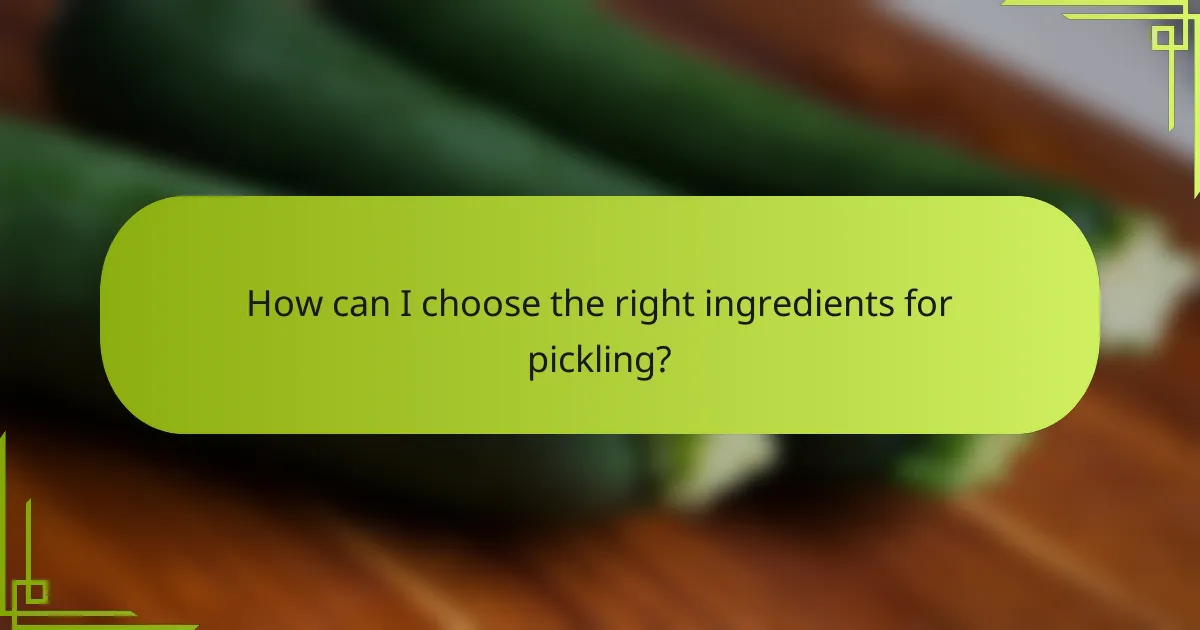
How can I choose the right ingredients for pickling?
Choosing the right ingredients for pickling is essential for achieving the desired flavor and preservation. Focus on fresh, high-quality vegetables, fruits, and spices, as they significantly impact the final product.
Fresh Vegetables and Fruits
Selecting fresh vegetables and fruits is crucial for successful pickling. Look for produce that is firm, unblemished, and in-season to ensure optimal flavor and texture. Common choices include cucumbers, carrots, radishes, and green beans.
Consider the size and shape of the produce, as uniform pieces will pickle more evenly. For example, small cucumbers are ideal for whole pickles, while larger ones may need to be sliced or quartered.
Vinegar Selection
The type of vinegar you choose can greatly influence the tanginess of your pickles. Common options include white vinegar, apple cider vinegar, and rice vinegar, each offering distinct flavors. Aim for a vinegar with a 5% acidity level to ensure proper preservation.
Experiment with different vinegars to find the flavor profile that suits your palate. For instance, apple cider vinegar adds a fruity note, while rice vinegar offers a milder taste.
Spices and Seasonings
Spices and seasonings are vital for enhancing the flavor of your pickles. Common spices include dill, mustard seeds, coriander, and peppercorns. You can also add garlic or chili flakes for an extra kick.
When seasoning your pickles, consider the balance of flavors. A good rule of thumb is to start with a basic recipe and adjust the spices according to your taste preferences.
Salt Types
Salt is essential for pickling, as it helps draw out moisture and enhances flavor. Use pickling salt or kosher salt, as they dissolve easily and do not contain additives that can cloud the brine.
Avoid table salt, which contains anti-caking agents that can affect the clarity and taste of your pickles. Generally, a ratio of about 1 to 2 tablespoons of salt per quart of brine is a good starting point.







